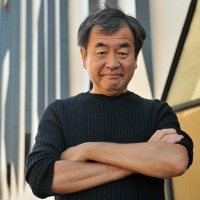Kengo Kuma, working with Ejiri Structural Engineers and the Kengo Kuma Laboratory at The University of Tokyo, the installation is an exploration of pliancy, precision, lightness and strength: by pulling two ends, it naturally de-forms and half of the woven structure is lifted into the air.
Bamboo has been used traditionally in Japanese architecture in part due to its linearity and flexibility, and as a symbol of strength and rapid growth. The basic component of the structure – a 2m-diameter ring – is made from strips of the bamboo Phyllostachys edulis. By combining carbon fibre, a contemporary material, with the traditional material of bamboo and laminating each ring, the resulting effect achieves a certain rigidity while maintaining the unique material properties and beauty of bamboo – a remarkable, sustainable material that resonates with Kuma’s childhood memories and looks into the future of architecture.




























